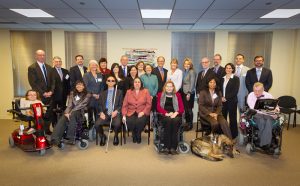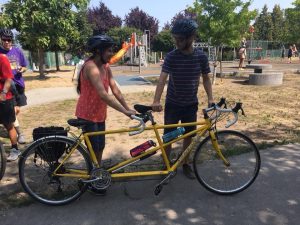Guest Blog Post By: Jinnie Saran

Often, when people are met with something that they are unfamiliar with, it can spark a feeling of extreme discomfort and intimidation. From my personal experience and from what I have learned through my intercultural communications class, this is typically due to the fact that people are unsure of how to interact in these situations as they do not have the necessary knowledge and cultural sensitivity to communicate. Generally, people do not want to do or say the wrong thing therefore; this can also lead them to avoid asking any question from the people they encounter such as those whom may have disabilities.
When culture comes to one’s mind disability doesn’t usually fall under that umbrella. However, people with disabilities identify as their own cultural groups. For instance, a popular one is deaf culture and blind culture, as these groups also have their own languages, sign language, and codes such as Braille. In the article “ Disability as a cultural identity,” it is suggested that with the right control from people who are disabled, special education schools have the potential to become positive sights for the promotion of disability in a positive cultural identity. It is also conveyed that this could offer disabled children and their families a genuine choice within their education. Although some people with disabilities such as myself wish to be integrated into the main stream educational system, some people wish to stick closer to their cultural identity. For example, people who are deaf within the United States, may wish to attend Gauldet University as the people there are already familiar with their language and accepting of who they are.
Due to people having disabilities, it is often not thought that they too will be traveling our world and making connections with others. In the article “ Intercultural communication and disabilities from a communication complex perspective (Parrish-Sprowl, 2015),” it is expressed that 10 percent of the world’s population is comprised of people with a disability and are often overlooked. However these people are being mainstreamed within cultures as well as traveling to other countries along with others who are now more frequently traveling due to technological advances. The disabled are marginalized and discriminated against within their own country, therefore when the able bodied interact with those who have a disability interculturally the challenge is greater. The article suggests that people with disabilities should be taken into consideration when developing skills and in future studies conducted.
It is important for the able bodied society to know not only that they can ask individuals with disabilities questions, but also what steps they themselves can take to foster and uphold an inclusive environment. In the TEDx Talk “Blind is Beautiful” (Saran, 2018) I discuss my own challenges with my disability and explain how we can not only educate society about this topic, but how to also incorporate the learning about disabilities within the educational system. Throughout my educational journey, I have learned about various minorities in depth, and yet disability was seldom mentioned. Perhaps this may be why communication and interaction between the disabled and able bodied is quite challenging.

Due to many misconceptions held by society people with disabilities are often deprived of the physical activity they need or crave. In his TEDx Talk, “People with disability are athletes too,” David Kyle (2017) describes their journey with their disability and becoming a athlete. They stress the importance of physical activity for all people.
People with disabilities struggle with the same challenges that able bodied people experience, it is just that they do things slightly differently. In the video “Blind Parenting,” (Marsolais, 2016) this is demonstrated quite accurately. Shawn Marsolais explains her experience with parent-hood and how though it has been difficult meeting other moms, that she believes her son has become a better communicator due to having a blind mother. She also stresses the point that she deals with the same challenges any working mother would.
Though the sources and information presented here are quite accurate in providing a basis of understanding and a gateway in building connections among the physically challenged and able-bodied, there is no way to replace the face-to-face experience and chance to ask questions for both groups as even two people with the same challenges are still different people. All one needs to do is view this as a characteristic of our personality and hopefully that makes things slightly easier. Remember, just start with “Hello.”
To find out more and increase your intercultural competency, following is a list of places to start:
Kyle, D. (2017). People with Disabilities Are Athletes Too. TEDX Talks. https://www.youtube.com/watch?v=huh80afjfCc
Lawson, J. (2001). Disability as a Cultural Identity. International Studies in Sociology of Education.
Marsolais, S. (2016). Blind Parenting. Accessible Media Inc. https://www.youtube.com/watch?v=RqMTmW2kYJc
Parrish-Sprowl, J. (2015). Intercultural Communication and Disabilities from a Communication Complex Perspective. Russian Journal of Linguistics.
Saran, H. (2018). Blind Is Beautiful. TEDX Talks. https://www.youtube.com/watch?v=D-YajTp_7O4

